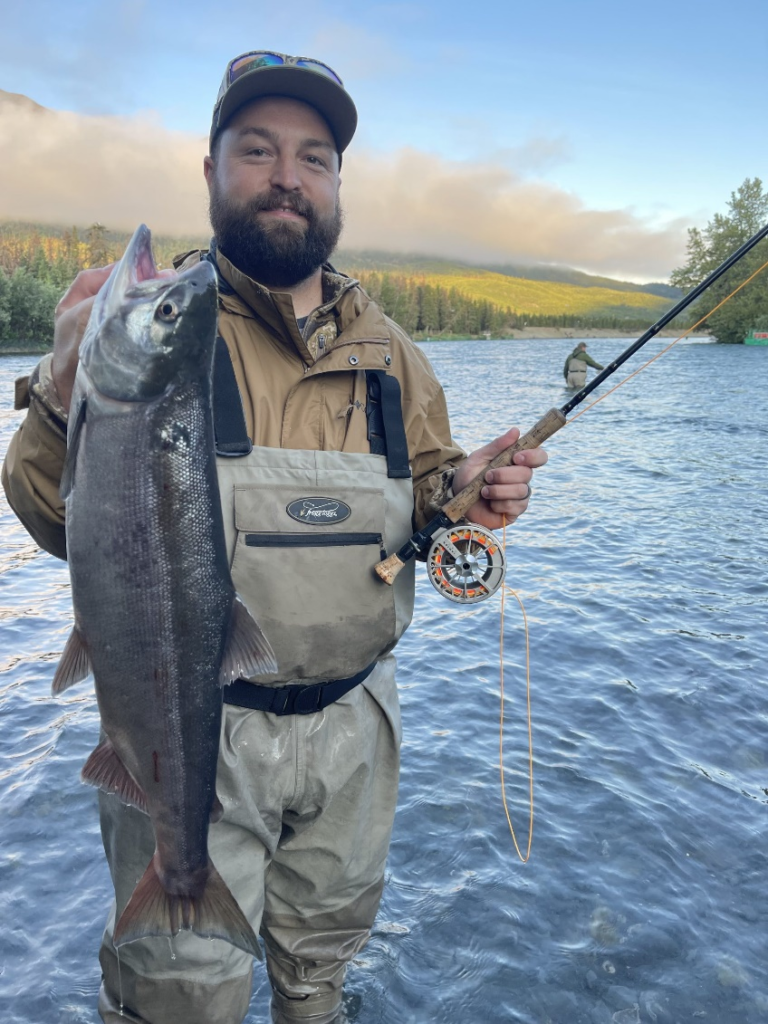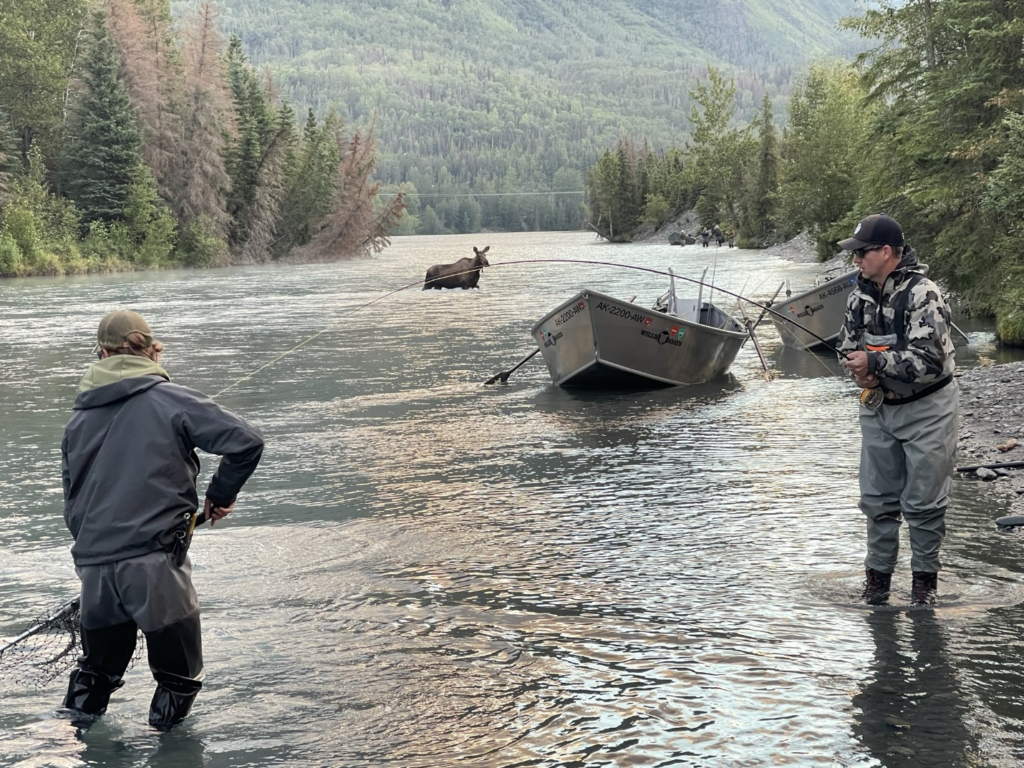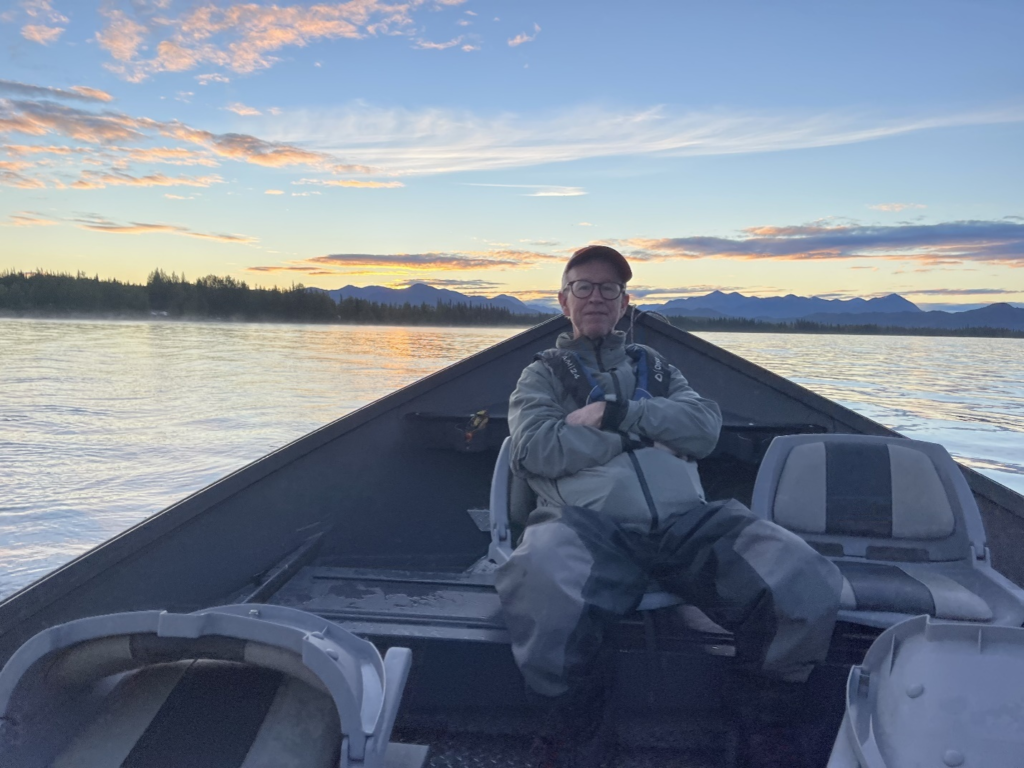There’s something utterly captivating about the rhythmic movement of a fly rod, the delicate dance of the line through the air, and the tension as the fly lands on the water’s surface.
But what if we told you there’s a place where this serene art form meets the exhilarating rush of battling some of the world’s most sought-after fish? Welcome to the Kenai River, a fishing paradise nestled in the heart of Alaska’s wilderness and the starting point of an adventure you won’t forget!
When you think of the ultimate fishing experience, what comes to mind? Perhaps you envision the glassy surface of a remote lake or the sun-dappled waters of a babbling brook. But the Kenai River offers so much more than just picturesque scenery.
The 82-mile-long river winds through the Kenai Peninsula, teeming with diverse fish species and offering unrivalled opportunities to master the art of fly fishing.
Are you ready to dive in? Let’s explore the techniques and strategies that’ll transform you from a novice to a seasoned angler in no time!
1. Understand the Kenai River Ecosystem
Before diving into the specific techniques and strategies, make sure you develop a good understanding of the Kenai River itself. The river is divided into three sections: the Upper Kenai, Middle Kenai, and Lower Kenai. Make sure you know where you’ll be fishing and the particular species present. This will help you tailor your approach and enjoy a successful fishing trip.
Recommended Read: The Best Time to Fish the Kenai River
2. Select the Right Gear

Invest in a high-quality fly rod and reel suitable for the species you target and the water conditions you encounter. For rainbow trout and Dolly Varden, a 6-8 weight rod is recommended, while a 9-10 weight rod is better suited for salmon.
Length is another critical factor to consider. 9 to 10-foot rods are the most versatile for the Kenai River. Invest in a durable and reliable fly reel that matches your rod weight and line requirements. A smooth drag system will help you pull in strong fish easily.
Larger arbor reels are recommended as they allow for faster line retrieval and better line management. Select an appropriate fly fine for the type of fishing you plan to do on the Kenai River.
Weight-forward floating lines are the most versatile as they’re suitable for both nymphing and dry fly fishing. However, sinking tip or full sinking lines are excellent for targeting fish in deep water or during high water conditions.
Use the right leader and tippet material for your chosen fly fishing technique. For dry fly fishing, use a tapered leader that provides a delicate presentation and turns over the fly efficiently. For nymphing or streamer fishing, opt for a level or slightly tapered leader with a heavier tippet.
Fluorocarbon tippet is recommended for its abrasion resistance and low visibility in the water. Equip yourself with a well-organized fly box that contains a variety of patterns to imitate the local insect life and baitfish. Use dry flies, nymphs, and streamers.
3. Learn the Essential Casts
Master various casting techniques to achieve fly fishing success on the Kenai River. Start with the basic overhead cast, perfect your timings, and gradually move on to more advanced casts like roll cast, single and double haul, and reach cast.
Each cast has its specific application. Understand when and how to use them to significantly improve your chances of hooking into a trophy fish.
4. Read the Water
If you want to master the art of fly fishing on the Kenai River, learn how to read the water like a seasoned pro. Identify the areas where fish are likely to hold, e.g., seams, riffles, and deep pools. Look for structures like rocks, fallen trees, and undercut banks that provide cover for fish.
Once you develop a good understanding of where fish are most likely to be found, you’ll be able to focus your efforts and maximize your chances of success.
5. Master the Drift

A natural, drag-free drift will help you present your fly in a way that entices fish to strike. By controlling your line, mending, and adjusting your casting angle, you can achieve the perfect drift. Use these tips to master the drift:
- Mending: Mending is the technique of repositioning your fly line on the water to minimize drag and achieve a natural drift. As your fly line moves downstream, it’s influenced by varying currents that can cause it to move at different speeds.
By lifting and flipping your line upstream, you can counteract these currents and maintain a drag-free drift. Practice mending both upstream and downstream to adapt to different fishing situations on the Kenai River.
- Casting Angles: Adjusting your casting angle can significantly impact the quality of your drift. By casting slightly upstream, you can give your fly more time to sink and allow it to drift naturally with the current. Experiment with different casting angles to find the most effective approach for the specific water conditions and target species.
- Line Management: If you want to maintain a natural drift, proper line management is crucial. Make sure you have the right amount of line out and that it is free of tangles or loops. Keep a close eye on your line and be prepared to strip or feed out additional line as needed to maintain the desired drift length.
- Strike Detection: Pay attention to your strike indicator, the end of your fly line, or any subtle movements in the water that may indicate a fish has taken your fly. React quickly and set the hook with a firm but controlled motion to increase your chances of landing the fish.
- Adjusting for Depth: When fly fishing the Kenai River, you may encounter various water depths and current speeds. Adjust your rig and technique accordingly to present your fly at the right depth for the target species. This may involve changing the length of your leader, adding or removing split shot, or switching between different fly patterns or line types.
Recommended Read: Putting the Bullseye on Your Target Species
6. Choose the Right Flies
Familiarize yourself with the local insect life and baitfish that make up the primary food sources for the fish you’re targeting. Stock your fly box with various patterns that imitate these natural food sources, and be prepared to switch flies based on the time of day, water conditions, and fish behavior.
7. Adapt to Changing Conditions

The Kenai River’s conditions can and will change rapidly. Pay close attention to changes in water levels, clarity, temperature, and weather. Adjust your approach accordingly. This may mean switching fly patterns, adjusting your leader length, or changing your casting techniques to suit the current conditions.
8. Observe Fish Behavior
Keen observation of fish behavior will help you refine your fly fishing techniques on the Kenai River. Look for signs of feeding, e.g., rising fish or birds diving into the water. Observe how the fish react to your fly and make adjustments in your presentation, fly pattern, or retrieve speed as needed. Understand the nuances of fish behavior to fine-tune your approach and increase your catch rate.
Are you ready to catch your dream fish? Jason’s Guide Service should be your first stop! Our experienced, dedicated, and skilled fly fishing guides help you enjoy an exhilarating fishing experience and achieve fly fishing mastery.
Whether you’re interested in pink salmon fishing, a guided rainbow trout trip, or guided silver salmon fishing, we’re here to take you under our wing. Book your Kenai River fishing trip today!


